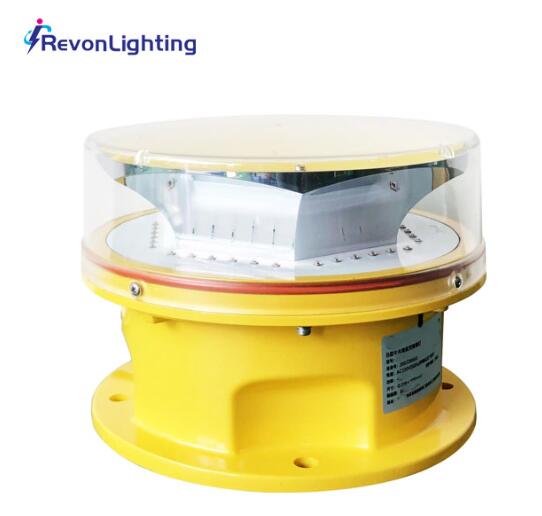Posted: 2024-07-17
In the aviation industry, ensuring the safety of aircraft as they navigate around obstacles is of paramount importance. Two critical elements in this safety framework are medium intensity obstruction lights and FAA L-864 lights. These lights are essential for marking taller structures that pose potential hazards to aircraft, particularly during low visibility and night-time operations. This article explores the characteristics, regulatory requirements, and technological advancements associated with medium intensity obstruction lights and FAA L-864 lights.
Medium Intensity Obstruction Lights
Medium intensity obstruction lights are designed to mark obstacles that are between 200 and 500 feet (60 to 150 meters) in height. These lights are visible from a significant distance and are crucial for preventing collisions with aircraft. They are typically used on structures such as communication towers, buildings, and wind turbines.
Characteristics
Intensity Levels: Medium intensity obstruction lights are brighter than low-intensity lights but not as intense as high-intensity lights. They are designed to be highly visible without causing excessive glare.
Color and Flashing Patterns: These lights can be either red or white. White medium intensity lights are often used during daytime, while red lights are used at night. The flashing pattern of these lights is also critical; they usually flash at a regular interval to attract attention.
Energy Efficiency: Advances in LED technology have significantly improved the energy efficiency of medium intensity obstruction lights. LEDs consume less power and have a longer lifespan compared to traditional incandescent lights.
Applications
Communication Towers: These lights are commonly installed on tall communication towers to ensure they are visible to aircraft.
Wind Turbines: Wind turbines, especially those located near flight paths, use medium intensity lights to mark their presence.
Buildings: High-rise buildings in the vicinity of airports or within flight paths are marked with medium intensity obstruction lights to enhance visibility for pilots.
FAA L-864 Obstruction Lights
FAA L-864 obstruction lights are a specific type of medium intensity light mandated by the Federal Aviation Administration (FAA) for marking certain types of structures. These lights are part of the regulatory framework that ensures uniformity and safety in the marking of obstacles.

Characteristics
Red Flashing Lights: FAA L-864 lights are red and flash at a regular interval, typically 20-40 flashes per minute. This flashing pattern helps in distinguishing these lights from other types of lights in the environment.
Visibility: Designed to be visible from great distances, FAA L-864 lights provide a clear warning to pilots of the presence of obstacles.
Durability: These lights are built to withstand harsh environmental conditions, including extreme temperatures, wind, and precipitation. This durability ensures that the lights remain functional and reliable.
Applications
Transmission Towers: High transmission towers often use FAA L-864 lights to mark their presence, ensuring that they are visible to aircraft at all times.
Tall Buildings: Buildings exceeding certain heights near flight paths are required to install FAA L-864 lights to enhance visibility and safety.
Other Tall Structures: Any tall structure that poses a risk to aircraft, such as chimneys and bridges, may be required to use FAA L-864 lights to comply with FAA regulations.
| Medium Intensity Obstruction Light | FAA 864 |
| 13 | 15 |
Regulatory Aspects
The use of medium intensity obstruction lights and FAA L-864 lights is governed by stringent regulations set by the FAA and other aviation authorities to ensure safety and uniformity.
FAA Guidelines
Advisory Circular 70/7460-1L: This document provides detailed guidelines on the marking and lighting of obstructions. It specifies the types of lights required, their intensity, color, and placement on structures.
Inspection and Maintenance: Regular inspection and maintenance of obstruction lights are required to ensure they remain functional. This includes checking the integrity of the lights, cleaning lenses, and replacing any faulty components.
Certification and Compliance: FAA L-864 lights must be certified to meet specific performance standards. This certification process ensures that the lights provide consistent and reliable illumination.
Technological Advancements
Recent technological advancements have greatly enhanced the performance and efficiency of medium intensity obstruction lights and FAA L-864 lights.
LED Technology: The adoption of LED technology has revolutionized obstruction lighting. LEDs provide brighter and more consistent illumination, consume less energy, and have a longer operational life compared to traditional lighting solutions.
Smart Lighting Systems: Modern obstruction lights can be integrated into smart systems that allow for remote monitoring and control. These systems can automatically adjust the intensity of the lights based on ambient conditions and provide real-time status updates.
Solar Power: Solar-powered obstruction lights are increasingly popular due to their sustainability and cost-effectiveness. These lights harness solar energy during the day and operate independently of the electrical grid, making them ideal for remote locations.
Improved Weather Resistance: Advances in materials and design have improved the weather resistance of obstruction lights. Modern lights are more capable of withstanding extreme environmental conditions, ensuring they remain operational in all weather scenarios.
Conclusion
Medium intensity obstruction lights and FAA L-864 lights are essential components of aviation safety, providing critical visibility for tall structures that could pose hazards to aircraft. The FAA's stringent regulations ensure that these lights are properly installed and maintained, while technological advancements continue to improve their performance and reliability. As the aviation industry evolves, the role of effective obstruction lighting will remain crucial in maintaining safe and efficient air travel. The integration of advanced technologies such as LED lighting, smart systems, and solar power will further enhance the effectiveness of these lights, ensuring the continued safety of the skies.